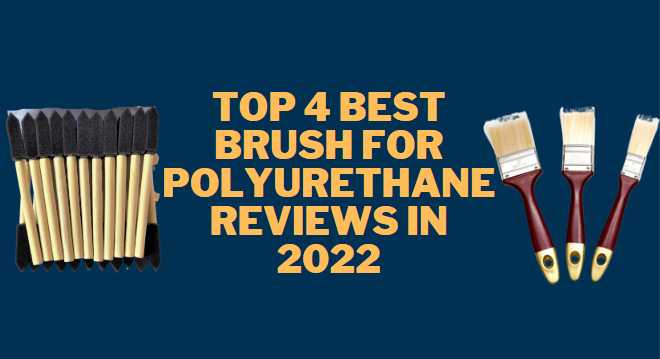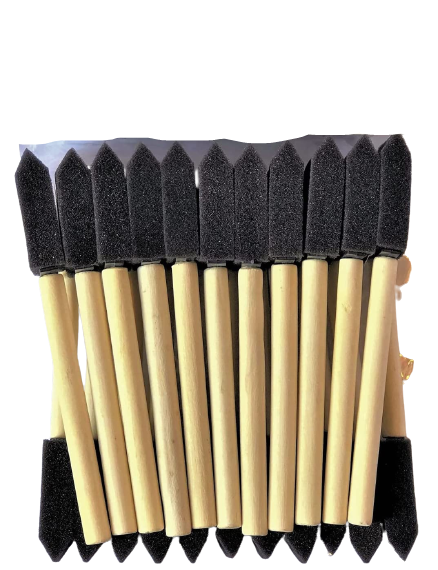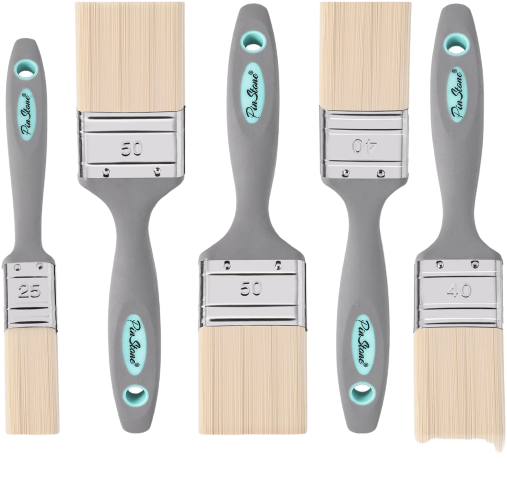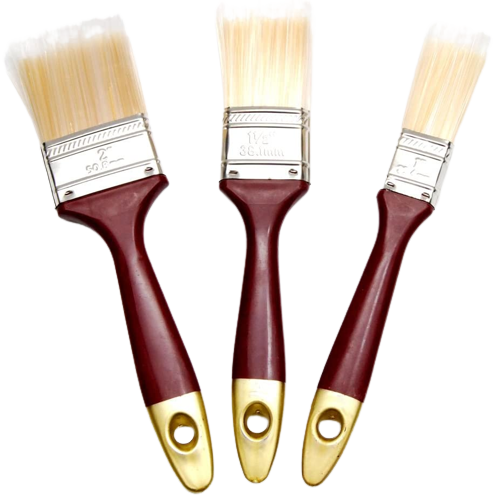
Choosing the right brush for polyurethane is important to ensure a smooth, even coat. Not all brushes are created equal, so it’s important to do your research before making a purchase.
In this blog post, we’ll explore four of the best brushes for polyurethane and share our top picks. We’ll also provide tips on how to choose the right brush for your needs. Let’s get started!
Image | Model | Feature | Link |
PANCLUB Foam Brush Set I Sponge Brush Paint I 2 Inch | comfortable to hold and provide good control. | ||
PinStone House Paint Brush Set, 5 Pack | easy to clean and can be reused again and again. | ||
Hometeq - 2 inches, 1.5 inches, 1 inch Paint Brushes | durable option that will last through multiple painting projects. | ||
Wooster 5221-2 1/2 Brush 5221-2-1/2 Tip Angle Sash | easy to paint tight corners and hard-to-reach areas. |
- Top 4 Best Brush for Polyurethane
- Foam brush for polyurethane
- Best brush for water-based polyurethane
- Best Brush for Oil-Based Polyurethane
- Best Brush for Spar Urethane
- Things to Consider When Choosing the Best Brush for Polyurethane – Buyer’s Guide
- Considerations for Buying A Paint Brush For Polyurethane
- FAQs
- What’s the best way to apply polyurethane?
- Can I use a paintbrush for polyurethane?
- What do you do with a brush between coats of polyurethane?
- How do I get a smooth finish with polyurethane?
- Can you use a sponge brush to apply polyurethane?
- What kind of brush for polyurethane?
- Enlist some Type of brush for polyurethane?
Top 4 Best Brush for Polyurethane
Foam brush for polyurethane
Polyurethane is a type of synthetic resin that is used in a variety of applications, from coatings and adhesives to insulation and packaging. When applied correctly, polyurethane can be an extremely durable material. However, one of the challenges of working with polyurethane is that it can be difficult to spread evenly.
A foam brush is one tool that can be used to apply polyurethane. Foam brushes are designed to hold a small amount of material, which helps to prevent drips and runs. In addition, the soft, pliable nature of foam allows it to conform to irregular surfaces, making it ideal for use on moldings and trim.
When applying polyurethane with a foam brush, be sure to work in small sections and use even strokes. With a little practice, you’ll be able to achieve a professional-looking finish. Among all the available options, I think PANCLUB Foam Brush Set suits best a given purpose.
PANCLUB Foam Brush Set I Sponge Brush Paint I 2 Inch – 20 Pack I with Wood Handles I Best Paint Brush for Polyurethane, Applying Polyurethane with Foam Brush, Foam or Bristle Brush for Polyurethane

PANCLUB Foam Brush Set is the perfect way to apply polyurethane to your project. The set includes 20 foam brushes with wood handles, making it easy to get a smooth, even coat of polyurethane. Foam or bristle brushes can be used for polyurethane, and the foam brushes provide a nice, even finish.
The set also includes a carrying case so you can keep your brushes organized and protected. This is a great set for anyone who wants an easy way to apply polyurethane.
Specifications
The PANCLUB Foam Brush Set is a versatile set of sponge brushes that can be used for a variety of applications. The set includes 20 brushes, each with different width and density. The dimensions of the brush head range from 2 inches to 3 inches, and the overall length of the brush range from 5 inches to 6 inches.
The brushes are made from high-quality materials and are covered by a one-year warranty. They are also compliant with all major safety standards. Whether you’re painting a wall or polishing a piece of furniture, the PANCLUB Foam Brush Set is an excellent choice.
Pros
- The handles are comfortable to hold and provide good control while painting.
- The foam heads are firm but flexible, making them ideal for applying paint to both flat and textured surfaces.
- The 2-inch size is perfect for most painting projects, and the set includes a convenient storage case to keep the brushes organized.
Cons
- The brushes are not very versatile and can only be used for painting.
Best brush for water-based polyurethane
When it comes to finishing hardwood floors, water-based polyurethane is one of the most popular choices. It provides a durable finish that resists scratches and scuffs, and it’s easy to apply. However, choosing the right brush for applying water-based polyurethane can be a challenge. There are two main types of brushes: natural bristle and synthetic.
Natural bristle brushes are made from animal hair, while synthetic brushes are made from man-made materials. Each type has its own advantages and disadvantages. Keeping all the factors in consideration, I think the PinStone House Paint Brush Set will perform well when used.
PinStone House Paint Brush Set, 5 Pack Small Paint Brush, Rubber Handle, Latex Water Based Paint Brushes for Painting, Best Brush to Apply Polyurethane

The PinStone House Paint Brush Set is the best brush to apply polyurethane. The set includes five small paint brushes with rubber handles and latex water-based paint. The set is also easy to clean and maintain. The brushes are made of high-quality materials and are durable. They are also comfortable to use and provide a good grip.
The set is ideal for painting small areas and is perfect for touch-ups. The brushes are also great for applying paint to stained glass and other difficult-to-reach areas. The set is an excellent value for the price and is a great addition to any painter’s toolkit.
Specifications
The PinStone House Paint Brush Set is a 5 pack of small paint brushes with rubber handles and latex water-based paint. The set includes a 2″, 3″, 4″, 5″, and 6″ brush. The brushes are made of nylon and have a stainless steel ferrule.
They are compliant with ASTM D4236 and are safe for use with all types of paint, including oil-based, acrylic, and water-based paints. The set comes with a limited-year warranty.
Pros
- This set includes five small paint brushes, each with a rubber handle for comfortable grip and precision.
- The bristles are made from soft yet durable nylon, and they’re perfect for use with water-based paints.
- Whether you’re painting trim, walls, or furniture, these brushes will give you a smooth, even finish.
- They’re easy to clean and can be reused again and again.
Cons
- The rubber handles can make the brushes slippery, which can lead to accidents.
Best Brush for Oil-Based Polyurethane
When choosing a brush for oil-based polyurethane, it is important to select one that is specifically designed for use with this type of product. Natural bristle brushes are the best choice for oil-based polyurethane, as they are able to hold more material and provide a smoother application.
Synthetic brushes can also be used, but they may leave streaks or brush marks in the finish. For best results, always purchase a high-quality brush and follow the manufacturer’s instructions for use. With proper care, your brush will last for many years and provide a beautiful finish to all of your projects.
After considering all the factors, I’ve come to the conclusion that Hometeq – 2 inches, 1.5 inches, 1 inch Paint Brushes are the best among all.
Hometeq – 2 inches, 1.5 inches, 1 inch Paint Brushes Designed Latex or Oil Based Paints for Indoor or Outdoor with Comport Handle (3 Pack)

Hometeq paint brushes are specifically designed for use with latex or oil-based paints. The bristles are made of high-quality synthetic material that provides excellent paint coverage and a smooth finish. The comfortable grip handle ensures easy and precise application.
Hometeq paint brushes are perfect for both indoor and outdoor use. The three different brush sizes (2 inches, 1.5 inches, and 1 inch) give you the flexibility to tackle any painting project, big or small.
Specifications
The brushes come in three different sizes – 2 inches, 1.5 inches, and 1 inch – so you can choose the right size for the job at hand. The comfortable handles make them easy to use, and the high-quality bristles provide a smooth finish.
In addition, the brushes are backed by a 100% satisfaction guarantee, so you can be confident that you’re making a wise investment.
Pros
- The comfort handle provides a firm grip and makes it easy to maneuver the brush around corners and tight spaces.
- Hometeq’s paintbrushes are made with high-quality materials and construction, making them a durable option that will last through multiple painting projects.
Cons
- The price of the set is relatively high compared to other similar products on the market.
Best Brush for Spar Urethane
When applying spar urethane, it is important to use a brush that will not leave behind streaks or brush marks. For best results, choose a natural bristle brush. Synthetic bristles are more likely to shed, and they can also leave behind unwanted streaks.
Natural bristle brushes are less likely to shed, and they provide a smooth finish. In addition, natural bristles are less likely to absorb spar urethane, so you will not need to apply as much pressure when brushing. For these reasons, a natural bristle brush is the best choice for applying spar urethane.
Considering all the options, I think Wooster 5221-2 Tip Angle Sash Paintbrush is best for the given requirements.
Wooster 5221-2 1/2 Brush 5221-2-1/2 Tip Angle Sash Paintbrush, 2-1/2-Inch, 2-1/2 Inch, White, Silver

The Wooster 5221-2 1/2 brush is a top-quality sash paintbrush that is perfect for a variety of painting projects. The 2-1/2 inch brush has a natural bristle that is specially flagged to provide excellent paint coverage.
The silver ferrules are crimped and double-threaded for added security, and the wooden handle is comfortable to hold. The 5221-2 1/2 brush is also available in a 3-inch size.
Specifications
The brush is made with white bristles that are set in a silver ferrule. The bristles are soft and can hold a lot of paint, making it easy to apply an even coat of paint to your surface. The brush has a comfortable wooden handle that is easy to grip and control.
The length of the brush is 2.5 inches and the width is 2.5 inches. The Wooster 5221-2 1/2 Brush 5221-2-1/2 Tip Angle Sash Paintbrush, 2-1/2-Inch, 2-1/2 Inch, White, Silver comes with a limited year warranty. It is also compliant with the California Air Resources Board’s Phase II regulations.
Pros
- The 2-1/2 inch brush has an angled tip that makes it easy to paint tight corners and hard-to-reach areas.
- The white bristle brush is made of soft horsehair, which provides a smooth, even finish.
- The silver ferrule ensures durability and prevents rusting.
Cons
- The brush is only for use with water-based paints and stains, limiting its versatility.
Things to Consider When Choosing the Best Brush for Polyurethane – Buyer’s Guide
Type of Bristle
Choosing the right brush to apply polyurethane can be daunting because there are so many different types of bristles to choose from. But with a little knowledge about the pros and cons of each type of bristle, the decision can be much easier
Natural bristle brushes are made from animal hair, and they’re ideal for oil-based finishes like polyurethane. The bristles are stiff and hold a lot of finish, so they’re great for large surfaces. But natural bristles can also absorb water from the finish, which can make them swell and become misshapen
Synthetic bristles are made from nylon or polyester, and they’re less likely to absorb water than natural bristles. They’re also less expensive. However, synthetic bristles don’t hold as much finish as natural bristles, so they’re not ideal for large surfaces
Which type of bristle you choose will depend on your project and your budget. But whichever type you choose, make sure you get a high-quality brush to ensure a smooth, even finish.
Width and Style
When choosing a brush for polyurethane, two main factors must be considered: width and style. The width of the brush will determine how much area can be covered in a single pass, while the style of the brush will determine the final finish. For example, a flat brush will produce a smooth, even finish, while a round brush will create a textured finish.
In general, wider brushes are better for covering larger areas, while narrower brushes are better for precise work. Ultimately, the best brush for polyurethane is the one that best suits the job at hand.
Type of Handle
When choosing a brush to use with polyurethane, it is important to consider the type of handle that will be most comfortable for you. For example, if you have large hands, you may want to choose a brush with a longer or thicker handle. Conversely, if you have small hands, you may prefer a brush with a shorter or thinner handle.
In addition, to Handle Size, you should also consider the materials of the handle. For instance, wooden handles are often more comfortable to hold than metal handles. Finally, be sure to test the brush before purchasing it to ensure that it feels comfortable in your hand. With a little bit of research, you can find the perfect brush for your next polyurethane project.
Ferrule
The ferrule is the metal band that secures the bristles to the handle. A good ferrule will be made of stainless steel or another corrosion-resistant material. It should also be firmly attached to the handle, with no gaps or cracks. The bristles themselves should be made of natural or synthetic materials that are designed to resist corrosion.
Finally, the brush should have a comfortable handle that is easy to grip. With these factors in mind, you can choose the best brush for your needs.
Quality
The quality of the brush is also an important consideration. A high-quality brush will have a seamless ferrule that is securely attached to the handle. The bristles will be firmly set in the ferrule and evenly trimmed. In addition, the brush should feel well-balanced in your hand.
A cheap, poorly made brush will have bristles that are loose in the ferrule and unevenly trimmed. The brush will also feel unbalanced and may be uncomfortable to use.
Considerations for Buying A Paint Brush For Polyurethane
Water-Based Polyurethanes
When it comes to choosing the best brush for polyurethane, one important factor to consider is the type of polyurethane you are using. Water-based polyurethanes dry more quickly than oil-based formulas, which means you can complete your project in a shorter amount of time. In addition, water-based formulas are less likely to yellow over time and they emit fewer fumes, making them a more environmentally friendly option.
When using a water-based formula, it is important to choose a brush with synthetic bristles, as natural bristles can absorb too much moisture and cause the polyurethane to dry unevenly. With these factors in mind, water-based polyurethanes may be the best option for your next project.
Oil-Based Polyurethanes
Oil-based polyurethanes have a longer drying time than water-based polyurethanes, giving you more time to work with the material and make sure it is applied evenly. They also tend to level out more smoothly, resulting in a more consistent finish.
Another advantage of oil-based polyurethanes is that they are more resistant to heat and humidity, making them a better choice for use in kitchens and bathrooms. They also hold up better to wear and tear, making them ideal for floors and other high-traffic areas.
So, when considering oil-based or water-based polyurethanes, it really comes down to what you’re looking for in a finish. If you want something that looks more traditional and is very durable, then oil-based is the way to go. If you’re looking for something that dries quickly and has a more modern look, then water-based is the better choice. Ultimately, it’s up to you to decide which type of polyurethane is right for your project.
FAQs
What’s the best way to apply polyurethane?
For the best results, apply polyurethane with a natural bristle brush. Start by applying the finish to the edges of the piece, then work your way to the centre. Be sure to brush in the direction of the grain to avoid leaving brush marks.
Can I use a paintbrush for polyurethane?
Paintbrushes can be used for polyurethane, but they are not the ideal tool.
What do you do with a brush between coats of polyurethane?
To clean a brush between coats of polyurethane, dip it in mineral spirits or paint thinner and then wipe it on a rag. This will remove any excess polyurethane from the brush so that it doesn’t dry and become hard.
How do I get a smooth finish with polyurethane?
For a smooth finish, it is important to apply the polyurethane evenly and in the direction of the grain. You may also want to consider using a higher-quality brush for a smoother application.
Can you use a sponge brush to apply polyurethane?
While you can use a sponge brush to apply polyurethane, it is not the ideal tool. Sponge brushes tend to absorb too much polyurethane, which can result in an uneven finish.
What kind of brush for polyurethane?
The best brush to use for applying polyurethane is a natural bristle brush. Synthetic bristles can also be used, but they may absorb too much polyurethane and cause the finish to dry unevenly.
Enlist some Type of brush for polyurethane?
Some types of brushes that can be used for applying polyurethane include natural bristle brushes, synthetic brushes, and paintbrushes. However, the best type of brush to use is a natural bristle brush.
A wrench is a necessity of a home for small working. So, if you want to get a wrench then you should read this best adjustable wrench.



